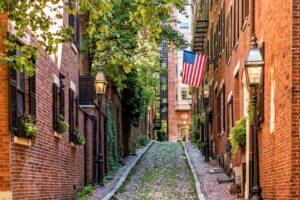Fodor's Expert Review Blackstone Block
Between North and Hanover Streets, near the Haymarket, lies the Blackstone Block, now visited mostly for its culinary landmark, the Union Oyster House. Named for one of Boston's first settlers, William Blaxton, or Blackstone, it's the city's oldest commercial block, for decades dominated by the butcher trade. As a tiny remnant of Old Boston, the Blackstone Block remains the city's "family attic"—to use the winning metaphor of critic Donlyn Lyndon: more than three centuries of architecture are on view, ranging from the 18th-century Capen House to the modern Bostonian hotel. A colonial-period warren of winding lanes surrounds the block.
Facing the Blackstone Block, in tiny Union Park, framed by Congress Street and Dock Square, are two bronze figures, one seated on a bench and the other standing eye-to-eye with passersby. Both represent James Michael Curley, the quintessential Boston pol and a questionable role model for urban bosses. It's just as well that he has no pedestal.... READ MORE
Between North and Hanover Streets, near the Haymarket, lies the Blackstone Block, now visited mostly for its culinary landmark, the Union Oyster House. Named for one of Boston's first settlers, William Blaxton, or Blackstone, it's the city's oldest commercial block, for decades dominated by the butcher trade. As a tiny remnant of Old Boston, the Blackstone Block remains the city's "family attic"—to use the winning metaphor of critic Donlyn Lyndon: more than three centuries of architecture are on view, ranging from the 18th-century Capen House to the modern Bostonian hotel. A colonial-period warren of winding lanes surrounds the block.
Facing the Blackstone Block, in tiny Union Park, framed by Congress Street and Dock Square, are two bronze figures, one seated on a bench and the other standing eye-to-eye with passersby. Both represent James Michael Curley, the quintessential Boston pol and a questionable role model for urban bosses. It's just as well that he has no pedestal. Also known as "the Rascal King" or "the Mayor of the Poor," and dramatized by Spencer Tracy in The Last Hurrah (1958), the charismatic Curley was beloved by the city's dominant working-class Irish for bringing them libraries, hospitals, bathhouses, and other public-works projects. His career got off to a promising start in 1903, when he ran—and won—a campaign for alderman from the Charles Street Jail, where he was serving time for taking someone else's civil-service exam.
Over the next 50 years he dominated Boston politics, serving four nonconsecutive terms as mayor, one term as governor, and four terms as congressman. No one seemed to mind the slight glitch created when his office moved, in 1946, to the federal penitentiary, where he served five months of a 6- to 18-month sentence for mail fraud: he was pardoned by President Truman and returned to his people a hero.
READ LESS






